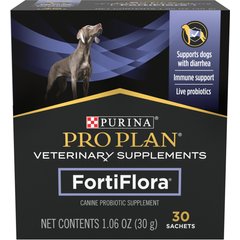Abnormal Growths in the Lower Intestines of Dogs
Rectoanal Polyps in Dogs
Rectoanal polyps is characterized by the growth of flap-like protrusions in the anal and rectal walls. The polyps may be directly attached to the intestinal wall (sessile), or attached through a stalk-like cylindrical connection.
Most rectoanal polyps are non-cancerous, and are merely extensions of the innermost tissue lining of the intestinal walls. And while most cases of polyps are usually isolated, there are occasions dogs suffer from multiple polyps.
The condition described in this medical article can affect both dogs and cats. If you would like to learn how rectoanal polyps affects cats, please visit this page in the PetMD health library.
Symptoms and Types
Dogs suffering from this condition will demonstrate straining or pain while passing stools. The stools may be stained with blood and/or covered with mucus.
Vet Recommended Health Support
- Purina Pro Plan Veterinary Diets FortiFlora Powder Probiotic Digestive Supplement for Dogs, 30 count$30.99Chewy Price
- VetClassics Pet-A-Lyte Oral Electrolyte Solution Dog & Cat Supplement, 32-oz bottle$17.99Chewy Price
- Nutramax Welactin Omega-3 Liquid Skin & Coat Supplement for Dogs, 16-fl oz$27.99Chewy Price
- Fera Pets USDA Organic Pumpkin Plus Fiber Support for Dogs & Cats, 90 servings$34.95Chewy Price
Causes
The exact cause of rectoanal polyps is not clearly known. However, middle-aged and older dogs are more likely to contract this disorder.
Diagnosis
Your veterinarian will perform a thorough physical exam on your dog, taking into account the history of symptoms and possible incidents that might have precipitated this condition. Some of the common tests include a complete blood count and a urinalysis, which will usually return as normal. Imaging tools, such as X-rays and ultrasounds, are not applicable to this particular diagnosis.
Some conditions that may produce symptoms similar to those caused by polyps include abscesses, tumors, inflammation, infection of the intestine, and rectal prolapse. Diagnosis, therefore, is usually made on the basis of a manual rectal examination by a veterinarian, or by direct visualization of the polyp through the external anal opening.
After a polyp is identified, a colonoscopy, using a tubular, flexible camera inserted through the anal opening, may be performed to check for the presence of other polyps. A detailed pathological study of the tissue, as well as the fluid from the polyp, may also be completed.
Treatment
Surgery is usually indicated for the effective management of polyps. The polyps may be removed through the anal opening, after which the anal opening will be closed with stitches. The same removal surgery may be performed endoscopically, or by using an electrical needle or probe. Some medications that may be prescribed are:
- Non-steroidal pain relievers
- Antibiotics (especially before surgery to prevent infection)
- Stool softeners
Possible complications include a relapse of the polyps and narrowing of the anal opening due to scarring and/or inflammation.
Living and Management
Your veterinarian will want to examine the surgical site after 14 days to make sure that the condition has been resolved and the tissue is healing properly.
Another examination will be made at three months, and again at six months after surgery. Follow-up examinations will continue twice a year to check for recurrence. Dogs with single polyps usually do not relapse, those with multiple or diffuse lesions are at a much higher risk for recurrence.




